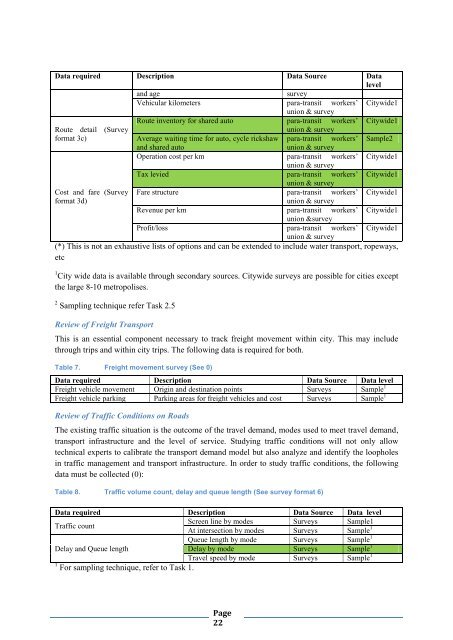Toolkits for Urban Transport Development - UNEP
Toolkits for Urban Transport Development - UNEP
Toolkits for Urban Transport Development - UNEP
Create successful ePaper yourself
Turn your PDF publications into a flip-book with our unique Google optimized e-Paper software.
Data required Description Data Source Data<br />
level<br />
and age<br />
survey<br />
Vehicular kilometers para-transit workers’ Citywide1<br />
union & survey<br />
Route inventory <strong>for</strong> shared auto para-transit workers’ Citywide1<br />
Route detail (Survey<br />
union & survey<br />
<strong>for</strong>mat 3c)<br />
Average waiting time <strong>for</strong> auto, cycle rickshaw para-transit workers’ Sample2<br />
and shared auto<br />
union & survey<br />
Operation cost per km para-transit workers’ Citywide1<br />
union & survey<br />
Tax levied para-transit workers’ Citywide1<br />
union & survey<br />
Cost and fare (Survey Fare structure para-transit workers’ Citywide1<br />
<strong>for</strong>mat 3d)<br />
union & survey<br />
Revenue per km para-transit workers’ Citywide1<br />
union &survey<br />
Profit/loss para-transit workers’ Citywide1<br />
union & survey<br />
(*) This is not an exhaustive lists of options and can be extended to include water transport, ropeways,<br />
etc<br />
1 City wide data is available through secondary sources. Citywide surveys are possible <strong>for</strong> cities except<br />
the large 8-10 metropolises.<br />
2 Sampling technique refer Task 2.5<br />
Review of Freight <strong>Transport</strong><br />
This is an essential component necessary to track freight movement within city. This may include<br />
through trips and within city trips. The following data is required <strong>for</strong> both.<br />
Table 7. Freight movement survey (See 0)<br />
Data required Description Data Source Data level<br />
Freight vehicle movement Origin and destination points Surveys Sample 1<br />
Freight vehicle parking Parking areas <strong>for</strong> freight vehicles and cost Surveys Sample 1<br />
Review of Traffic Conditions on Roads<br />
The existing traffic situation is the outcome of the travel demand, modes used to meet travel demand,<br />
transport infrastructure and the level of service. Studying traffic conditions will not only allow<br />
technical experts to calibrate the transport demand model but also analyze and identify the loopholes<br />
in traffic management and transport infrastructure. In order to study traffic conditions, the following<br />
data must be collected (0):<br />
Table 8. Traffic volume count, delay and queue length (See survey <strong>for</strong>mat 6)<br />
Data required Description Data Source Data level<br />
Traffic count<br />
Screen line by modes Surveys Sample1<br />
At intersection by modes Surveys Sample 1<br />
Queue length by mode Surveys Sample 1<br />
Delay and Queue length<br />
Delay by mode Surveys Sample 1<br />
Travel speed by mode Surveys Sample 1<br />
1 For sampling technique, refer to Task 1.<br />
Page<br />
22
















